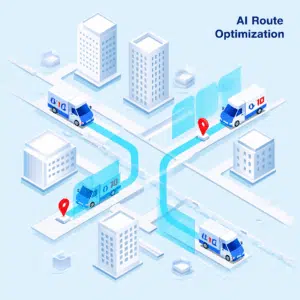Predictive analytics is a powerful tool for understanding and optimizing the performance of a supply chain. It aims to ensure that organizations optimize their supply chain networks to enhance efficiency and, eventually, achieve the business objectives and goals that they have in place.
Supply chain performance management (SCPM) streamlines the most successful supply chain management techniques, indications, metrics, and technology.
Predictive analytics, on the other hand, is an innovative tool that can help with the process by analyzing large volumes of data, identifying patterns and trends, and making informed decisions to optimize supply chain operations.
As the name indicates, predictive analytics is concerned with predicting future events such as sales demand, exchange rates, and other critical supply chain variables.
This article will offer a full explanation of performance management and predictive analytics, as well as how they are employed in supply chain management, and will cover the benefits of predictive analytics in general.
Understanding SCPM
Understanding the significance and necessity of performance management in the workplace is critical for a firm to fulfill its business objectives and goals. Companies that know what performance management is and how to execute it successfully have a competitive edge over their rivals. This is because successful performance management helps businesses in ensuring that they are getting the most out of their personnel, resources, and any processes put in place.
To accomplish the goals of supply chain management process analysis, SCPM utilizes both qualitative measures such as customer satisfaction and the quality of a company’s products, as well as quantitative supply chain KPIs such as the time it takes for a product to be delivered (OTD).
Ultimately, good supply chain performance management has significant benefits not just for supply chain processes but also for larger corporate objectives and business goals.
There are five essential performance attributes in supply chain performance management. The metrics used in performance management systems are intended to measure each of the SCOR qualities listed below.
- Reliability: Are your products delivered accurately and on schedule, while fulfilling all of the quality and quantity standards you set?
- Responsiveness: How fast do your products/services reach customers via the supply chain process?
- Flexibility: What is your level of ability to adjust to market changes (a shift in demand)?
- Costs: What are the expenses of managing your supply chain (storage, inventory management, labor, and transportation costs)?
- Asset Management: How efficiently do you manage your assets (inventory stocking levels, equipment, machines and vehicles etc.)?
SCPM Unlocks Untapped Supply Chain Performance Potential
Eliminating information barriers between different departments, commonly known as silos, can unlock a massive amount of untapped potential that businesses want to capitalize on in the face of growing prices, market uncertainties, and an ever-increasing need for flexibility.
Using a holistic approach to “Supply Chain Performance Management” (SCPM), it is now possible to compare data from multiple internal company departments such as purchasing and procurement (including cross-plant) with external data sources such as carrier systems to gain new insights and quickly identify supply chain risks and challenges.
Multifaceted Analytical Functions
There is a more pressing concern for businesses involved in logistics today than just identifying supply chain risks. This entails examining the implications of supply chain disruptions, such as delays in delivering products to customers: “Do I have enough stock on hand to ensure production, or do I need to reschedule?”
SCPM can assist here by comparing customer demand, actual in-transit status of inventories, and stocks in hand, and then delivering the results to material planners in an easy-to-understand format.
During the process, Supply Chain Performance Management helps in the overall optimization of plant logistics and transportation costs. For example, this might mean that on-site stocks should be maintained as low as possible while still ensuring production supply in all cases. SCPM provides a wide variety of analysis capabilities, and the results are displayed on well-organized dashboards.
This data comprises an evaluation of product quality, supplier and carrier delivery guarantee, cause analyses, numerous target/actual comparisons, use reports on particular services, data quality, inventory/demand studies, and transport or cost analyses down to the part number level.
Predictive Analytics in Supply Chain Management
Predictive analytics is among the most effective supply chain management tools (SCM) available to businesses today. Although it has existed for decades, predictive analytics solutions have only lately become popular and inexpensive enough to be employed by small and medium-sized businesses.
Companies can fine-tune their supply networks in ways that were just not conceivable previously, thanks to predictive analytics. The use of big data and predictive analytics to forecast customer behavior and optimize supply chain performance is becoming more common as data becomes more available.
Predictive analytics, strictly speaking, does not foresee the future, but rather employs probabilistic theories to identify what is likely to occur based on patterns and trends revealed by examining historical data. Other than increased CPU processing power, another significant aspect enabling the growing adoption of predictive analytics is the availability of data as a result of digitization and the widespread use of digital approaches.

How Do Supply Chain Managers Make Use of Predictive Analytics?
There are several examples of supply chain experts using predictive analytics to their advantage. Some of these include demand forecasting, predictive pricing techniques, and inventory management.
-
- Demand Forecasting: Predictive analytics enables businesses to improve demand forecasting by studying previous and present trends and anticipating demand using market information and economic predictions.
- Predictive Pricing Strategies: Predictive pricing strategies have the potential to overcome the constraints of traditional cost-plus pricing approaches or those that utilize a predefined margin. Instead, by anticipating product demand, it is now possible to dynamically change pricing according to market and economic conditions.
- Inventory Management: Predictive analytics, which employs complex algorithms, enables supply chain managers to estimate exact inventory requirements by area, location, and consumption. As a result, safety stock levels can be reduced and inventory put exactly where it is needed.
Building a Predictive Analytics Model for SCPM
Supply Chain Performance Management (SCPM) is based on controlling and managing the whole supply chain in order to maximize performance and decrease risk. SCPM can employ predictive analytics to identify possible issues before they occur, allowing for proactive decision-making and improved performance.
Here, we will look at the procedures involved in developing a predictive analytics model for SCPM and the tools and software that are utilized, as well as the various obstacles and best practices encountered in the process.
Steps to Building a Predictive Analytics Model for SCPM
-
- Explain the Problem: Start by identifying the problem you are attempting to resolve. This means evaluating essential performance measures for your supply chain, such as delivery times or inventory levels.
- Collect Data: Gather data on your supply chain processes, including historical and real-time data. This might include information on orders, inventory levels, shipment timelines, and supplier management.
- Data Collection: The information gathered may be riddled with human errors, missing data, and contradictions. This information has to be processed and prepared for analysis. It may include data transformation, standardization, and imputation.
- Pick a Predictive Analytics Model: Choose an appropriate predictive analytics model based on the identified issue and the data obtained. These might involve machine learning techniques like linear regression, decision trees, or neural networks.
- Model Training and Validation: Use the acquired data to train and evaluate the model. This might include dividing the data into training and testing sets, as well as cross-validation and hyper-parameter tweaking.
- Data Deployment and Analysis: Once the model has been trained and validated, it should be deployed in your SCPM system. Monitor the model’s performance on a regular basis and adjust it as needed.
Tools and Software Used for Predictive Analytics in SCPM
SCPM uses a wide range of predictive analytics tools and technologies, including statistical software such as R, Python, and SAS, as well as business intelligence applications such as Tableau, Power BI, and QlikView. Software available for predictive analytics such as IBM Watson Studio, DataRobot, and RapidMiner.
Amazon Web Services and Google Cloud Platform are all examples of cloud-based platforms.
Common Challenges while Building SCPM Predictive Analytics Models
- Poor Data Quality: Inadequate data quality can have a negative impact on the predictive analytics model’s effectiveness.
- Difficulty in Choosing the Appropriate Model: Selecting the right predictive analytics model necessitates a thorough grasp of the problem at hand as well as the data being used.
- Overfitting: Overfitting happens when the model is too complicated and too closely matches the training data, resulting in poor performance on fresh data.
Best Practices to Tackle Such Challenges
To tackle the aforementioned obstacles, consider the following best practices for developing predictive analytics models for SCPM:
- Begin with a well-defined problem statement and a set of performance measures.
- Invest in data quality and properly prepare the data before developing the model.
- Choose an appropriate model for the task and data at hand.
- Monitor the model on a regular basis to ensure it remains consistent over time.
In order to guarantee that the model is relevant and usable, include domain experts and stakeholders in the model-building process.

Examples of Companies Using Predictive Analysis in SCM
The majority of industries and businesses throughout the world have made predictive analytics a fundamental component of their work plans. Effective and sophisticated technologies are emerging to meet the growing demand, and there are several examples of predictive analytics being applied by major companies around the world, including Google, Netflix, and Amazon.
For instance, while Google may have the answer to everything, where does it get its answers? The number one search engine’s massive computing power and its ability to harness data-driven solutions are in turn driven by data analytics, Artificial Intelligence, and machine learning tools.
These resources offer Google greater visibility, deep market insights, and a complete view of suppliers and inventories to enable better predictability, execution efficiency, and decision-making.
If there is one thing that distinguishes organizations in their application of SCPM, it is their ability to effectively foresee requirements. Whether it’s only the next day’s sales or something more complicated, like the long-term product life cycle, firms that use predictive analytics in SCPM have an advantage in the market.
Predictive analytics can remove much of the guesswork from planning and decision-making processes. Supply chain predictive analytics, as opposed to historical analytics, helps supply chain management to foresee and plan for the future more effectively.
Final thoughts
Although SCPM can help in the achievement of corporate goals and objectives such as increased profits and enhanced information flow, the proper performance management system must be in place.
Many firms manage these operations using basic excel spreadsheets, BI tools, ERP systems, and other inadequate techniques.
However, once Supply Chain Performance Management is utilized holistically and as an integrated model alongside all other supplier-related collaboration processes, the analytical operations become deeply incorporated and provide the finest possible benefits.
At RTS Labs, we’ll help identify your biggest tech wins. Let’s start with a call to discuss how to improve your technology, and where you’ll see the biggest wins. No obligation, no selling.






